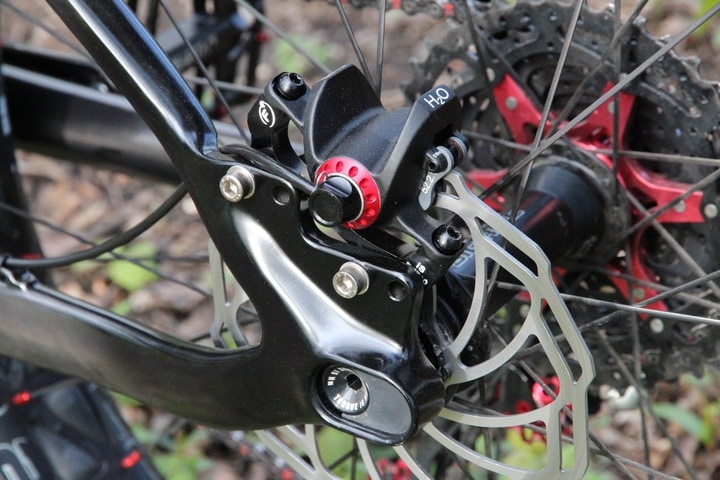
If you ride a bike, then maintaining brake health should be a top priority, period. Every cyclist should know how to repair bicycle brakes.
The effectiveness of bike brakes reduces over time. This can be caused by a variety of things but most of the time it's due to the pads wearing away and the cables stretching and loosening.
In this blog post, we’ll go over how to adjust bike brakes so that you can avoid these problems early on and make sure that your bike is safe to ride.
Table of Contents
Before you learn how to how to adjust front bike brakes, let’s take a look at how you can evaluate their condition. Here's a simple method for testing your brakes:
1. While standing next to your bike, pull on the front brake lever and try to move the bike forward. Typically, the rear tyre should move up and the brake lever shouldn't be able to come into contact with the handlebar.
2. Do the same thing for the rear brake. Check if the rear tyre locks up like it should when you try to push the bike forward.
If your bike brakes don't respond normally to these actions, then it’s high time to make some adjustments.

As mentioned above, worn-out brake pads are one of the commonest causes of brake failure. Let’s look at how we can adjust them so that they last longer:
Brake pads are the small pads that press down on the front tyre whenever your squeeze the brake lever.
Brake pads have 'wear lines' or 'wear indicators' which are thin grooves cut into them. Examine carefully to see whether they're worn past the wear lines. In other words, whether the grooves are shallow to the point that they're pretty much non-existent. If so, you’ll need to replace them.
In healthy brake systems, the pads should:
a) Touch the front tyre's rim at the same time
b) Hit the center of the rim, leaving an equal gap above and below it
If the pads are touching somewhere other than the center of the rim…
This points to a misalignment issue in the pads. If the pads are hitting higher than the center then they can come into contact with rubber. On the other hand, if they clamp down too low, they could be hitting the bike’s spokes.
Both cases will result in the brake pads wearing away fast.
How can you fix this?
The solution, of course, is to align the brake pads properly:
1. Loosen up the bolts on the brake pad holder using an Allen wrench. Take care not to loosen them all the way to avoid the pads falling out of the holder.
2. With the bolts sufficiently loosened, you should be able to move the brake pads up and down. Position the pads so that they're touching the center of the tyre rim, avoiding the rubber and the spokes.
Tighten the bolts again by turning the Allen wrench clockwise. Test out the brakes and make sure that they're hitting the center of the rim. If they're a bit off, loosen the bolts and adjust as needed.
If only one of the pads is hitting the rim of the tyre…
This is usually an indication that you need to center the brakes. The method of centering can differ based on what type of brakes your bike has.
How to Adjust Side Pull Brakes
Play around with the adjuster screw located on the top of the caliper. Make a note of how the arms move as you screw in or out so you can position them accurately.
Certain side pull breaks don't come with an adjuster screw. In that case, simply loosen the fixing bolt that keeps the brake fastened to the frame of the bike, readjust the brake to the center, and then retighten the bolt.
How to Adjust Mountain Bike Disc Brakes
Disc brakes are commonly used in mountain bikes because they provide lots of stopping power and they perform well in bad weather.
Disc brakes come with Allen bolts that hold the cable to the frame. To move around the caliper, simply loosen up these two bolts using an Allen key. Then, once you're done adjusting disc brakes (i.e centering it), retighten the bolts.
If you're not very familiar with this type of brakes, then you may want to check out this comprehensive guide on how to adjust disc brakes.
How to Adjust V-Brakes
Each brake arm comes with a small screw located at the bottom which allows you to tweak the spring tension. If you want to move the misaligned brake pad away from the rim of the tyre, then screw it inwards so that you increase the spring tension. If you want to move it closer then screw in the opposite direction.
Be careful when you’re increasing the spring tension because it increases lever resistance, making it harder to pull on them. With some practice, you’ll learn how to tighten bike brakes just enough.

The easiest way to check this is by squeezing the brake levers. Ideally, they should at least 3.8 cm away from the handlebars when you pill then all the way. If the levers come into contact with the handlebars, that means the cables need to be tightened.
If the cables are only slightly loose, then all you need to do is loosen up the barrel adjusters (located where the brake cables are connected to the lever) a bit. When you loosen bicycle brakes barrel adjusters it tightens the brake cable, though not a whole lot.
Once you've you done that, squeeze the brake lever again to see if that sorts it out. If not, you'll need to adjust the caliper.
To start with, find the bolt on the caliper that's holding the brake cable and loosen it using an Allen wrench. Take care not to completely loosen the bolt. Instead, just turn the wrench counterclockwise around two to three times.
Once you've got the bolt sufficiently loosed, pull the cable slowly so that it sticks out beyond the bolt. This should cause the brake pads to close in on the rim of the tyre. Pull the cable until the pads tighten up just enough on the rim. Make sure that you can still turn the tyre afterward!
Tighten the caliper again using the Allen wrench. Turn the bolt clockwise until it won't turn anymore.
Now all that's left is to test out the brakes using the levers again. If you've loosened the barrel adjusters make sure to tighten them up before you give it a try.
Whether you’re adjusting mountain bike brakes or those on a simple road bike, the above methods should help you out. Most of the time it’s usually a worn-out brake pad or a loose cable.
Now that you know how to fix bike brakes, make it a habit to constantly check up on them. This will ensure that it’s always safe to ride your bike, whether you’re commuting to work or off-roading on a mountain trail.
Plus, if you learn you how to adjust hand brakes on a bike, you’ll never have to pay a mechanic ever again!
